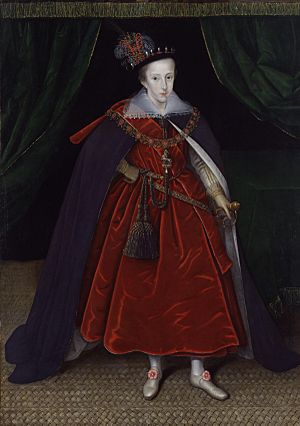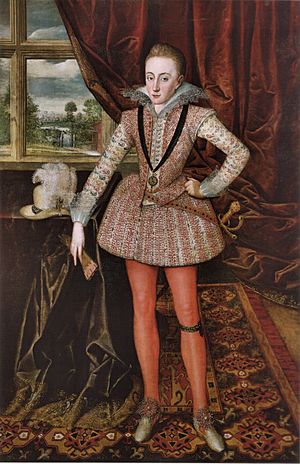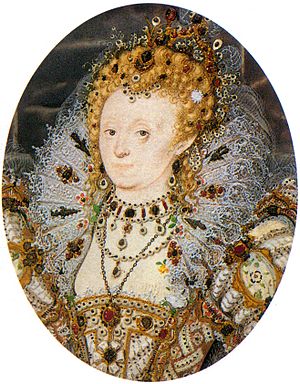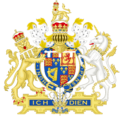Henry Frederick, Prince of Wales facts for kids
Quick facts for kids Henry Frederick |
|
|---|---|
| Prince of Wales (more) | |

Portrait after Isaac Oliver, c. 1610
|
|
| Born | 19 February 1594 Stirling Castle, Stirling, Scotland |
| Died | 6 November 1612 (aged 18) St James's Palace, London, England |
| Burial | 8 December 1612 Westminster Abbey |
| House | Stuart |
| Father | James VI and I |
| Mother | Anne of Denmark |
| Religion | Anglicanism |
Henry Frederick, Prince of Wales (born February 19, 1594 – died November 6, 1612) was the oldest son of James VI and I. James was the King of England and Scotland. Henry's mother was Anne of Denmark.
Prince Henry was named after his grandfathers: Henry Stuart, Lord Darnley and Frederick II of Denmark. People thought Henry was a very smart and promising future king. Sadly, he died at age 18 from typhoid fever. His younger brother, Charles, then became the next in line for the throne.
Contents
Growing Up in Scotland
Henry was born at Stirling Castle in Scotland. When he was born, he automatically received many important Scottish titles. These included Duke of Rothesay and Prince and Great Steward of Scotland.
His baptism on August 30, 1594, was a huge celebration. It included special plays and a ceremony in a new chapel at Stirling Castle. King James VI spent a lot of money on this event.
Henry's father, King James, placed him in the care of John Erskine, the Earl of Mar. Henry stayed at Stirling Castle until 1603. His tutor, Adam Newton, taught him.
King James often visited Henry at Stirling. When Henry was a baby, the King even joked about him making a pen stroke on a document. In 1596, Queen Elizabeth of England sent a small portrait of herself to Prince Henry. This gift was made by a famous artist named Nicholas Hilliard.
Moving to London
In 1603, King James became King of England too. This event is called the Union of the Crowns. Henry's family then moved south to England. His mother, Anne of Denmark, went to Stirling to bring Henry to Edinburgh. They then traveled to England.
Henry's tutor, Adam Newton, continued to teach him. The prince lived in different palaces, including Oatlands Palace and Nonsuch Palace. He moved to Winchester during a time when many people were getting sick from the plague.
In November 1603, Henry stayed at Wilton House. King James joked that a letter given to Henry by diplomats was bigger than the prince himself! Henry also rode with important people to dine with foreign ambassadors. This was his first public dinner outside the royal family.
On March 15, 1604, Henry rode on horseback behind his father through London. This was part of a big parade after his father's coronation. From 1604, Henry often stayed at St James's Palace. The gardens there were made better for him.
Hobbies and Sports
Prince Henry enjoyed many sports. At Stirling Castle, he had golf clubs and rackets. He also learned to dance and use a pike, which was a long spear.
In England, Henry learned music from different teachers. He also learned to dance and to fence. In 1603, Henry told a diplomat that he liked dancing, tennis, and hunting. In 1604, he danced for the Spanish ambassador and showed off his pike skills.
In 1606, a French ambassador noted that Prince Henry played golf. He described it as a Scottish game. Henry also played tennis. He even had a special court for a game called "pall-mall" at St James's Palace.
Henry wanted to learn to swim in 1607. However, some important earls told his tutor that swimming was too "dangerous" for a prince. A special riding school was built for him at St James's Palace in 1607. Henry also enjoyed horse riding and talked about different horse breeds. He even played chess indoors.
Personality and Training

King James wanted Henry's home to be like a "College rather than a Court." Henry loved physical activities like hunting, jousting, and fencing. He also studied naval and military matters. He often had different ideas from his father about national issues.
Henry was very popular, sometimes even more popular than his father. Their relationship could be difficult. Once, while hunting, King James criticized Henry. Henry rode off, and most of the hunting group followed him instead of the King.
Henry was known for being very honest and strict. He made anyone who swore in his presence pay a fine to a charity box. He also made sure his household attended church services regularly. He listened carefully to sermons.
Henry is said to have teased his younger brother, Charles. One story says Henry put a bishop's hat on Charles's head. He told Charles that when he became king, he would make Charles the Archbishop of Canterbury. Henry then joked that Charles would have a long robe to hide his "ugly rickety legs." Charles got very upset and cried.
Becoming a Leader

When his father became King of England in 1603, Henry immediately became Duke of Cornwall. In 1610, he was also made Prince of Wales and Earl of Chester. This meant he held important titles in both Scotland and England. His investiture ceremony was a big event with pageants and a masque. His mother gave him a diamond-covered sword, which represented justice.
As a young man, Henry showed great promise as a leader. He was involved in sending Sir Thomas Dale to the struggling English colony in North America. A city in colonial Virginia, Henricus, was named after him in 1611. His name is also found in Henrico County, Virginia and Cape Henry. He supported explorers looking for the Northwest Passage.
Henry was interested in Ireland. He was known to support making peace with Hugh O'Neill, Earl of Tyrone, a former Irish rebel. Because of this, Tyrone and his followers were sad when Prince Henry died.
In 1611, King James gave Woodstock Palace to Prince Henry. Henry built a special dining hall made of tree branches in the park. He held a dinner there for his parents and his sister, Princess Elizabeth.
Death
Henry died from typhoid fever when he was 18 years old. This happened during the celebrations for his sister Elizabeth's wedding. Doctors did a special examination after his death to stop rumors that he had been poisoned. It was said his last words were to ask for his sister.
After Henry's death, his brother Charles became ill. However, Charles was the main mourner at the funeral. King James, who disliked funerals, did not attend. Henry's body lay in state at St James's Palace for four weeks. On December 7, over a thousand people walked in the long funeral procession to Westminster Abbey. They listened to a two-hour sermon.
Prince Henry's death was a great tragedy for the country. Many people mourned him deeply. Henry's titles, like Duke of Cornwall, passed to Charles. Charles had always been in Henry's shadow. Four years later, Charles was made Prince of Wales.
Tributes in Literature and Music

Many writers and musicians created works to honor Prince Henry after his death. His chaplain, Daniel Price, gave several sermons about the young prince's passing. Price described Henry as a "perpetuall Paradise" and a "blessed Model of heaven."
Many poets wrote verses about Henry. Over 32 poets wrote about his death within a few months. These included Sir Walter Raleigh, who was a friend of Henry's. Famous poets like John Donne and Thomas Heywood also wrote about him.
Musicians also composed pieces in his memory. For example, Thomas Tomkins and Thomas Weelkes both wrote music inspired by the Biblical passage "When David heard." This passage is about King David mourning the loss of his son.
Titles and Honors
Titles Held
- February 19, 1594 – November 6, 1612: The Duke of Rothesay (and other Scottish titles)
- March 24, 1603 – November 6, 1612: The Duke of Cornwall
- June 4, 1610 – November 6, 1612: The Prince of Wales (and all his other titles)
Special Honors
- KG: Knight of the Garter, given on June 14, 1603. This is a very important award.
Coat of Arms
As Prince of Wales, Henry Frederick used the royal coat of arms. It had a special white "label of three points" to show he was the heir.
Images for kids
-
Portrait after Isaac Oliver, around 1610.
-
Elizabeth I sent a tiny portrait by Nicholas Hilliard to Prince Henry.
-
Portrait by Marcus Gheeraerts the Younger, around 1603.
-
Portrait by Robert Peake the Elder, around 1610.
-
Portrait of Prince Henry aged 13 or 14. He stands on a shield with his Prince of Wales's feathers.
See also
 In Spanish: Enrique Estuardo para niños
In Spanish: Enrique Estuardo para niños











